cheese making
Imagine a cheese with a nutty flavor and holes. That’s Swiss cheese. It’s loved by cheese fans everywhere. Its rich history and cheesemaking art make it special.
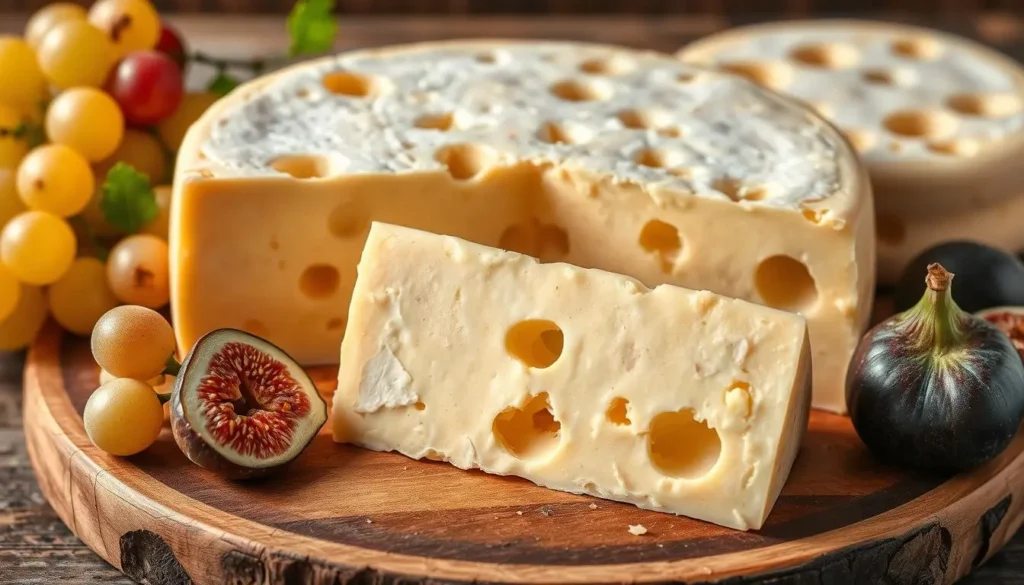
Key Takeaways
- Swiss cheese is known for its nutty taste and holes.
- Its history goes back to Switzerland’s alpine regions.
- Cheesemaking is an art that needs detail and old techniques.
- The science behind Swiss cheese’s holes is interesting.
- There are many types of Swiss cheese, each with its own taste.
Exploring the Iconic Swiss Cheese
Swiss cheese is a true gastronomic icon, loved for its unique taste and holes. Its nutty flavor and signature holes have won the hearts of cheese lovers everywhere.
What Makes Swiss Cheese Unique?
Several factors make Swiss cheese special. The use of emmental and swissland cheese cultures gives it a nutty taste and aroma. The slow aging process also creates the iconic holes, or “eyes,” that are a hallmark of this beloved cheese.
The History and Origins of Swiss Cheese
The history of Swiss cheese begins in the mountainous regions of Switzerland. For generations, skilled cheesemakers have perfected their craft. The first cheeses named after English villages were made in the 16th century by the proprietor of cheeses and butters in the Swiss countryside.
| Characteristic | Description |
|---|---|
| Flavor | Nutty, slightly sweet |
| Texture | Firm, with distinctive holes or “eyes” |
| Origin | Switzerland, primarily the Emmental and Gruyère regions |
| Aging Process | Slow, controlled aging allows for the development of the characteristic flavors and texture |
Over the centuries, Swiss cheese has become a beloved culinary icon. Its unique characteristics and rich heritage have made it a favorite among cheese enthusiasts worldwide.
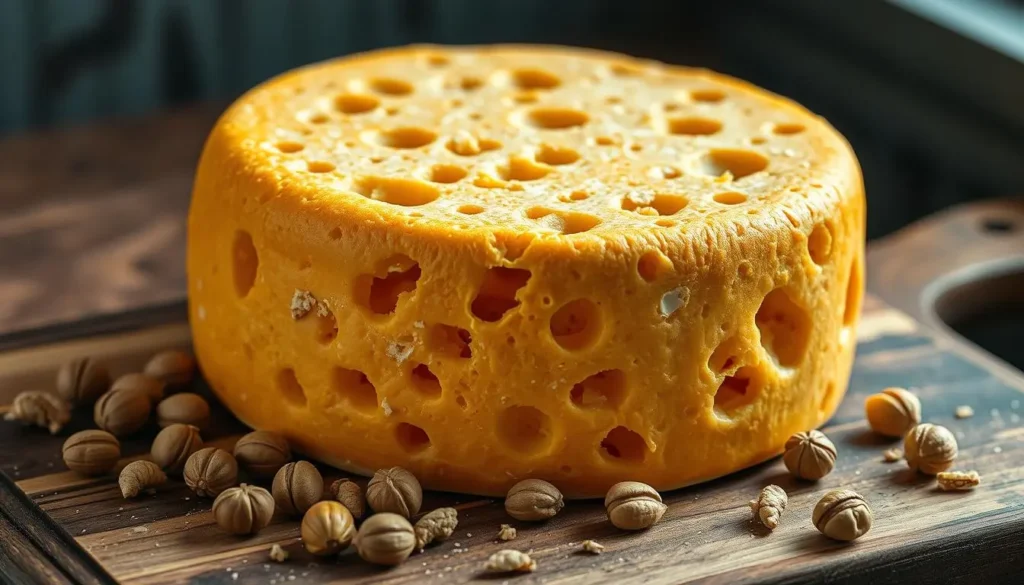
The Art of Cheesemaking
Making Swiss cheese is a true art form. It needs skill, patience, and attention to detail. From picking the best milk to managing each step, it shows the dedication of skilled artisans.
At the heart of Swiss cheese making is a delicate balance. Temperature, humidity, and aging are key. These factors shape the cheese’s flavor and the iconic holes.
The journey starts with the finest milk from Switzerland’s alpine pastures. This milk is then transformed through curdling, pressing, and maturation. Each step is a dance that shapes the cheese’s texture and taste.
| Stage of Cheesemaking | Description |
|---|---|
| Milk Selection | High-quality milk sourced from alpine pastures |
| Curdling | Coagulation of milk to form curds and whey |
| Pressing | Compaction of curds to remove excess moisture and shape the cheese |
| Aging | Maturation of the cheese under controlled temperature and humidity |
As the cheese ages, it changes in amazing ways. It develops a nutty flavor and the iconic holes. This shows the artistry and science of the cheesemakers.
“The true art of cheesemaking lies in the delicate balance of science and patience, where every step is crucial in shaping the final product.”
The tradition of Swiss cheese making is a wonder. It goes from the Swiss Alps to Europe’s cheese caves. It’s a craft passed down through generations, showing the passion and skill of those who make it.
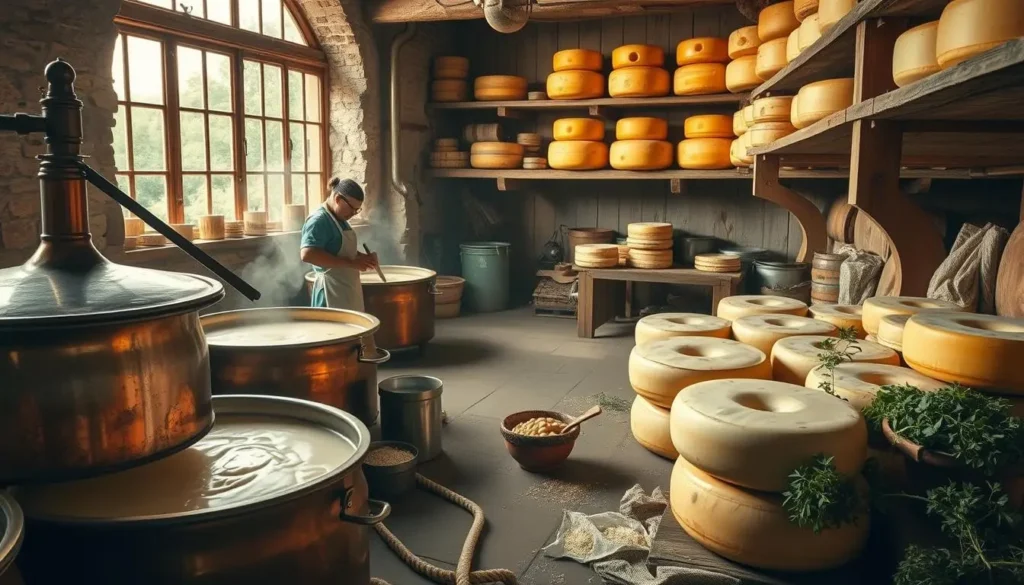
The Nutty, Holey Texture of Swiss Cheese
Swiss cheese is a treat for the senses, with its holes and nutty taste. Its unique texture and flavor come from aging, ripening, and cheesemaking science.
Understanding the Holes in Swiss Cheese
The holes in Swiss cheese, called “eyes,” form during aging. Bacteria in the cheese make carbon dioxide gas. This gas gets trapped, creating the holey pattern we love.
The size and where these holes appear depend on temperature, humidity, and the bacteria used. Cheesemakers control these factors to get the perfect holey texture.
The Science Behind the Nutty Flavor
The nutty taste of Swiss cheese comes from aging and ripening. As it matures, proteins and fats break down. This creates the cheese’s unique flavor.
Aging lets enzymes change the cheese. They turn milk sugar into lactic acid and break down proteins. This makes Swiss cheese taste nutty and slightly sweet.
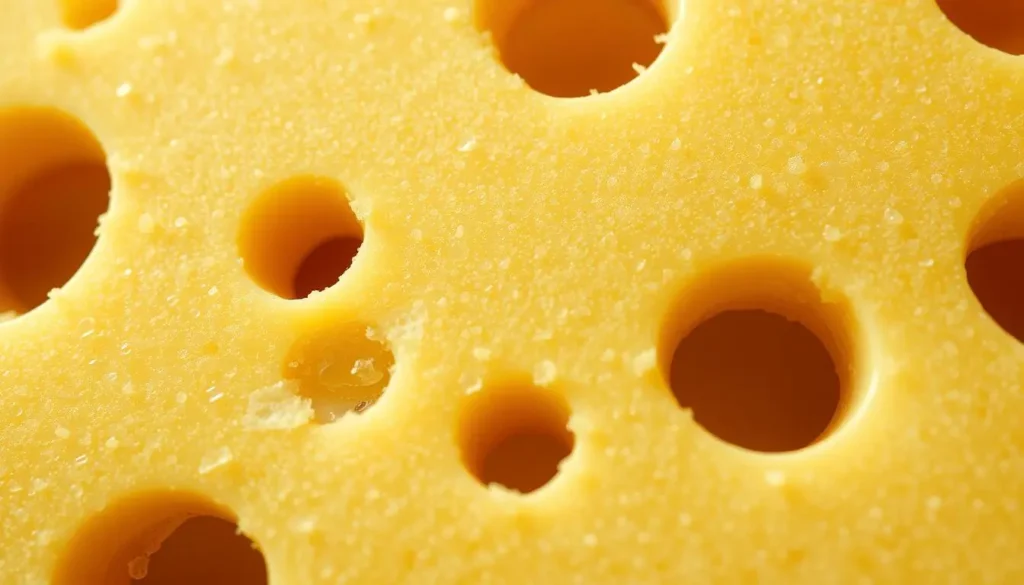
“The magic of Swiss cheese lies in the harmony of its holey texture and nutty flavor, a result of centuries of cheesemaking expertise.”
Varieties of Swiss Cheese
Swiss cheese is famous for its many varieties. Each one has its own special taste and look. Emmental is the most famous Swiss cheese, loved by cheese lovers everywhere.
Emmental: The Original Swiss Cheese
Emmental is called the “king of Swiss cheeses.” It’s a semi-hard, yellow cheese with holes and a nutty, sweet taste. It comes from the Emmental Valley in Switzerland and is loved all over the world.
The cheese’s holes are what make it special. These holes come from gas bubbles in the cheese as it ages. The size and number of these holes are important for the cheese’s taste and feel.
Switzerland also has other types of white cheese and cheese that starts with g. There’s creamy Gruyère and tangy Sbrinz, among others. These cheeses are perfect for different tastes and recipes.
| Cheese Variety | Flavor Profile | Distinctive Features |
|---|---|---|
| Emmental | Nutty, slightly sweet | Characteristic holes, semi-hard texture |
| Gruyère | Creamy, slightly nutty | Firm, smooth texture |
| Sbrinz | Tangy, robust | Hard, crystalline texture |
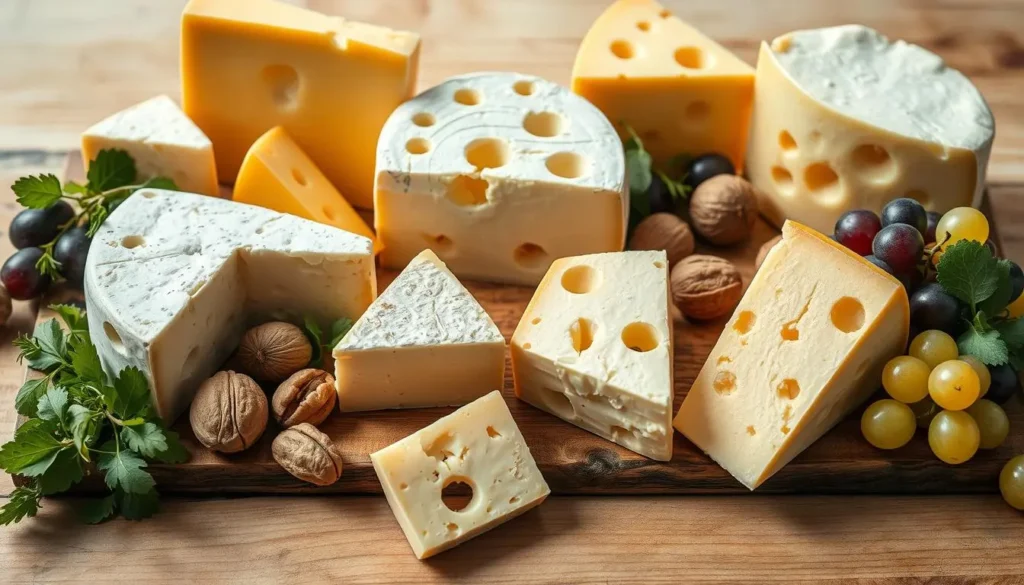
These types of white cheese and cheese that starts with g from Switzerland are a feast for the senses. They offer a wide range of flavors and textures, pleasing cheese lovers everywhere.
Aging and Ripening Process
The ripening process is key in making the famous Swiss cheese. It involves controlling temperature and humidity carefully. This process changes the cheese, making it taste, feel, and look unique.
As the cheese ages, a special balance between bacteria and enzymes happens. Cheesemakers work hard to keep this balance right. They make sure the cheese gets the best conditions to grow.
The aging time varies, from months to years, depending on the Swiss cheese type. The cheese changes a lot, getting robust and complex flavors and a smooth and creamy texture.
“The aging process is where the magic happens. It’s where the cheese truly comes into its own, revealing the depth and richness that make Swiss cheese so beloved.”
Every detail in the aging and ripening process is carefully planned. This includes temperature, humidity, and bacterial cultures. It’s this focus that makes Swiss cheese stand out, offering a unique taste experience.
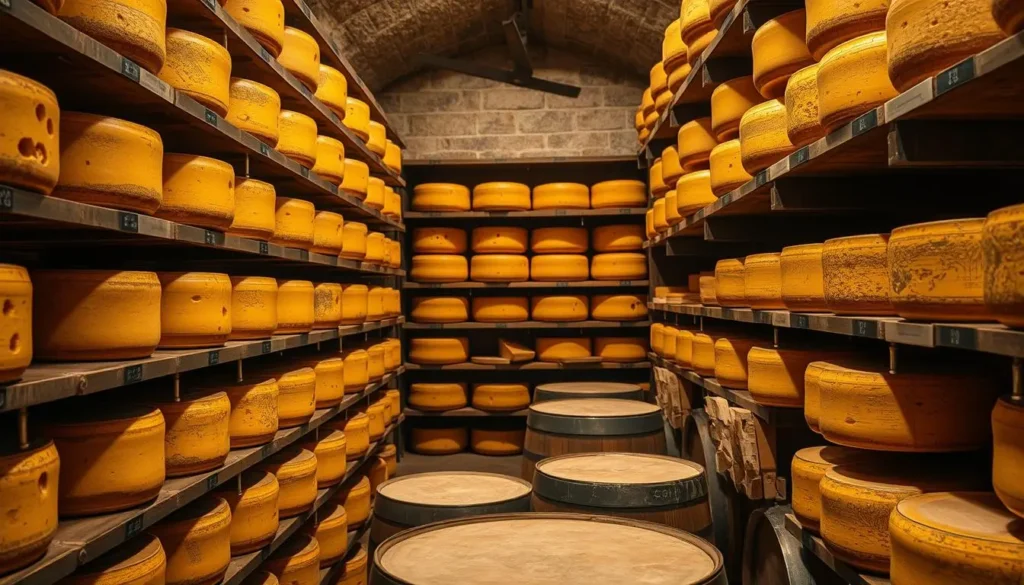
Swiss Cheese in the Kitchen
Swiss cheese is incredibly versatile. It can make many dishes better. It adds depth, texture, and flavor to your cooking. Find out how Swiss cheese can make your meals special.
Versatile Recipes with Swiss Cheese
Swiss cheese is great in many recipes. It’s perfect in classic grilled cheese sandwiches. Its nutty taste goes well with crispy bread.
It’s also great in hearty casseroles and comforting soups. It makes them creamy. Try baked Swiss cheese bites or Swiss cheese-stuffed chicken breasts for something fancy.
Swiss cheese is not just for traditional dishes. It’s also good in innovative culinary creations. Make Swiss cheese-based sauces for veggies or Swiss cheese-infused mashed potatoes. The options are endless.
“Swiss cheese’s nutty flavor and melty texture make it a kitchen staple that can elevate a wide range of dishes.”
Swiss cheese is perfect for any meal. It can make your recipes stand out. Whether it’s a quick dinner or a big dinner party, Swiss cheese is a reliable choice.
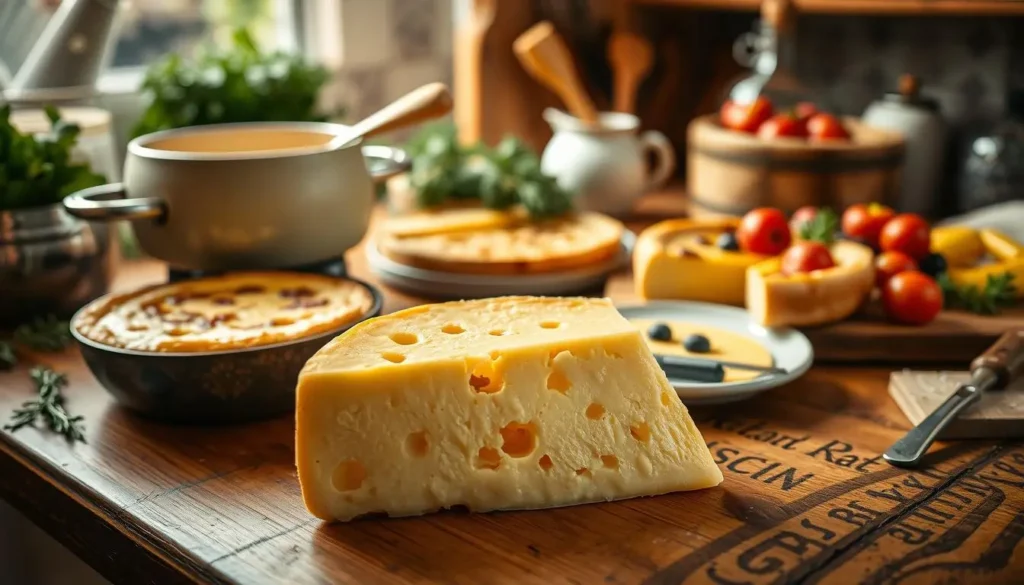
Health Benefits of Swiss Cheese
Swiss cheese is not just tasty and iconic. It also has many health benefits that make it great for your diet. Let’s explore the nutritional profile of this cheese. We’ll see how aging and ripening boost its health properties.
Swiss cheese is packed with protein, offering about 8 grams per ounce. This protein is essential for muscle growth and repair. It also has a lot of calcium, with one ounce giving you around 220 milligrams. Calcium is key for strong bones and teeth, making Swiss cheese good for bone health.
The aging and ripening process of Swiss cheese adds special health benefits. As it matures, it gets more of good stuff like conjugated linoleic acid (CLA) and vitamin K2. CLA helps with reduced inflammation and heart health. Vitamin K2 helps your body use calcium better, which is great for bones.
| Nutrient | Amount per Ounce | % Daily Value |
|---|---|---|
| Protein | 8 grams | 16% |
| Calcium | 220 milligrams | 22% |
| Vitamin K2 | 2.1 micrograms | 18% |
| Conjugated Linoleic Acid (CLA) | 0.1 grams | N/A |
Enjoying Swiss cheese as a standalone snack or in your favorite recipes is a smart choice. Its health benefits make it a great pick for better nutrition and well-being.
Pairing Swiss Cheese with Wines and Beers
Swiss cheese’s unique taste makes it great with many wines and beers. Finding the best pairings can make meals more enjoyable. It lets you enjoy the mix of flavors and textures.
Whether you love wine or beer, the right match can make your cheese dishes even better. The nutty, slightly sweet Swiss cheese goes well with different drinks. For wine fans, a crisp white or a light red can enhance the cheese’s richness. Beer lovers might prefer the hoppy IPA or the sweet Belgian ale to balance the cheese’s creaminess.
- Emmental Swiss cheese pairs beautifully with a dry, aromatic white wine like Riesling or Sauvignon Blanc.
- For a classic pairing, try Gruyère Swiss cheese with a medium-bodied red wine, such as a Cabernet Sauvignon or Merlot.
- Aged Swiss cheese, with its deeper, nuttier notes, can be a delightful companion to a malty, caramel-tinged beer like a doppelbock or a Belgian Dubbel.
Trying out different pairings of Swiss cheese with your favorite wines and beers is a fun journey. It’s a chance to find the perfect match that brings out the best in both the cheese and the drink.
The Iconic Role of Swiss Cheese in Pop Culture
Swiss cheese has become a beloved and iconic symbol in popular culture. It has moved beyond being just a dairy product. It has captured the hearts of people all over the world.
From classic films to contemporary art, Swiss cheese has made a big impact. It has become a cultural touchstone.
The comedy film “The Swiss Cheese Conspiracy” is a great example of Swiss cheese’s fame. In this movie, a group of cheese lovers go on a quest. They want to find out the secrets of Swiss cheese’s holes. The movie is full of laughs and has been loved by many for years.
“Swiss cheese has become a character in its own right, with its distinctive holes and nutty flavor becoming as recognizable as any Hollywood star.”
Swiss cheese has also made its mark in fine art. Pop artist Andy Warhol featured the cheese wedge in his famous silk-screen prints. These vibrant prints have become a big part of galleries and museums. They show how Swiss cheese’s unique look has captured people’s hearts.
| Iconic Pop Culture Appearances of Swiss Cheese | Impact on Popularity |
|---|---|
| The Swiss Cheese Conspiracy (1978 film) | Cemented Swiss cheese’s status as a beloved comedic character |
| Andy Warhol’s Pop Art Prints | Elevated Swiss cheese to the level of a pop culture icon |
| Cameos in TV shows like “Friends” and “The Simpsons” | Reinforced Swiss cheese’s widespread recognition and appeal |
Swiss cheese has become a true pop culture phenomenon. Its iconic status and famous associations have made it a beloved symbol. It has won the hearts of people all over the world.
Visiting Cheese Factories in Switzerland
For cheese lovers, visiting Switzerland’s famous cheese factories is a must. Here, you can see how Swiss cheese is made. Watch as skilled artisans use old methods to create this delicious cheese.
Experiencing the Cheesemaking Process
Step into Switzerland’s cheese factories and dive into the rich history of cheese. See how swissland cheese curds are made and how the cheese ages in cellars.
Talk to the cheesemakers and learn about the science and skill behind swissland cheese. Watch as fresh milk turns into the famous cheesemaking process loved by all.
“The art of cheesemaking is not just a job, but a way of life in Switzerland. Each wheel of cheese is a testament to the dedication and passion of our skilled artisans.”
On the factory tour, discover the secrets of Swiss cheese’s holes and taste. Learn about the old traditions and new techniques that make this cheese so special.
Whether you love cheese or are new to it, a swissland cheese factory tour in Switzerland is unforgettable. Get ready to be amazed by the sights, sounds, and tastes of Swiss cheese.
A Global Favorite
Swiss cheese has become a favorite around the world. It’s loved for its taste and has become a staple in many kitchens. Its popularity knows no borders.
The cheese’s unique flavor and holes have won many fans. It’s great in fondue or on sandwiches. This makes it a favorite in many places.
Its rich history and careful making process have made Swiss cheese famous. It’s known for quality and tradition. This is why it’s loved in markets worldwide.
| Country | Swiss Cheese Consumption (per capita) |
|---|---|
| Switzerland | 21.8 kg |
| Germany | 15.2 kg |
| United States | 12.9 kg |
| France | 11.6 kg |
The table shows Swiss cheese is loved worldwide. It’s a hit in Europe and North America. Its loyal fans make it a global favorite.
“Swiss cheese is the ultimate comfort food, transcending borders and bringing people together through its unique and beloved flavors.”
From Emmental to Gruyère, Swiss cheese delights everyone. Its lasting popularity shows it’s a beloved global icon.
Storing and Caring
Keeping Swiss cheese fresh means following the right steps for storage and care. Whether you love cheese or just want to enjoy Swiss, knowing how to keep it fresh is key. It makes a big difference in how you experience your cheese.
To keep Swiss cheese’s special taste and holes, watch the temperature and humidity. Store it in the fridge at 35°F to 40°F. Keep the humidity at 80% to 90%.
For packaging, don’t use airtight containers. They trap moisture and can spoil the cheese faster. Choose breathable wraps or cheese paper instead. This lets the cheese stay fresh and keeps its texture right.
To handle your Swiss cheese well, cut along the rind with a sharp knife. Don’t cut through the middle. This keeps the cheese’s holes and stops it from drying out or crumbling too soon.
| Storage Tip | Recommendation |
|---|---|
| Temperature | 35°F to 40°F |
| Humidity | 80% to 90% |
| Packaging | Breathable wraps or porous cheese paper |
By sticking to these easy storage and care tips, you can enjoy Swiss cheese’s special qualities. And you’ll get to savor its delicious taste for a longer time.
Conclusion
In this guide, you’ve explored the world of Swiss cheese. You learned about its history, how it’s made, and its special qualities. Swiss cheese is loved everywhere for its holes and nutty taste.
Whether you love cheese or are just starting to, this article has given you a new view. It shows the art and science behind Swiss cheese.
As you finish your last bite, remember the summary points. Swiss cheese is great in many dishes, from fondue to new recipes. The key takeaways on health, pairings, and culture will make you want to learn more.
Is a delight for the senses. It shows the hard work and love of cheesemakers over the years. With its history, special qualities, and appeal, Swiss cheese invites you to a world of artisanal delights.
FAQ
What makes Swiss cheese unique?
Swiss cheese is known for its nutty taste and holes. These features come from the cheesemaking process and aging stages.
What is the history and origin of Swiss cheese?
comes from Switzerland’s alpine regions. It has evolved into a global favorite, shaped by local traditions and environment.
How is Swiss cheese made?
Making Swiss cheese is an art that needs skill and patience. It involves selecting good milk and controlling temperature and humidity. The process shapes the cheese’s final look and taste.
What causes the holes in Swiss cheese?
The holes come from a scientific process during aging. Temperature, humidity, and bacteria play a role in their formation.
What gives Swiss cheese its nutty flavor?
The nutty taste comes from aging. Chemical and biological changes during this time create its unique flavor.
What are the different varieties of Swiss cheese?
Swiss cheese has many styles, each with its own traits. Emmental, the original, has influenced others. Each variety has its own taste, texture, and look.
How does the aging and ripening process affect Swiss cheese?
Aging and ripening are key in Swiss cheese making. They shape the cheese’s flavor, texture, and look. This process involves controlling temperature and humidity and the action of bacteria and enzymes.
How can Swiss cheese be used in the kitchen?
Swiss cheese is versatile and can be used in many dishes. Its flavor and texture can elevate various meals, making it a kitchen staple.
What are the health benefits ?
Swiss cheese is tasty and healthy. It’s rich in protein, calcium, and other nutrients. The aging process adds to its health benefits, making it a nutritious choice.
What are the best wine and beer pairings ?
Swiss cheese pairs well with many wines and beers. Finding the right pairings can enhance your dining experience, thanks to its unique flavor.


1 thought on “Swiss Cheese: A Nutty, Holey Delight for Cheese Lovers”